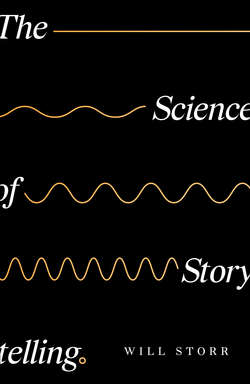Читать книгу The Science of Storytelling - Уилл Сторр - Страница 18
1.9
ОглавлениеSo our mystery is solved. We’ve discovered where a story begins: with a moment of unexpected change, or with the opening of an information gap, or likely both. As it happens to a protagonist, it happens to the reader or viewer. Our powers of attention switch on. We typically follow the consequences of the dramatic change as they ripple out from the start of the story in a pattern of causes and effects whose logic will be just ambiguous enough to keep us curious and engaged. But while this is technically true, it’s actually only the shallowest of answers. There’s obviously more to storytelling than this rather mechanical process.
A similar observation is made by a story-maker near the start of Herman J. Mankiewicz and Orson Welles’s 1941 cinema classic Citizen Kane. The film opens with change and an information gap: the recent death of the mogul Charles Foster Kane, as he drops a glass globe that contains a little snow-covered house and utters a single, mysterious word: rosebud. We’re then presented with a newsreel that documents the raw facts of his seventy years of life: Kane was a well known yet controversial figure who was extraordinarily wealthy and once owned and edited the New York Daily Inquirer. His mother ran a boarding house and the family fortune came after a defaulting tenant left her a gold mine, the Colorado Lode, which had been assumed worthless. Kane was twice married, twice divorced, lost a son and made an unsuccessful attempt at entering politics, before dying a lonely death in his vast, unfinished and decaying palace that, we’re told, was, ‘since the pyramids, the costliest monument a man has built to himself’.
With the newsreel over, we meet its creators – a team of cigarette-smoking newsmen who, it turns out, have just finished their film and are showing it to their boss Rawlston for his editorial comments. And Rawlston is not satisfied. ‘It isn’t enough to tell us what a man did,’ he tells his team. ‘You’ve got to tell us who he was … How is he different from Ford? Or Hearst, for that matter? Or John Doe?’
That newsreel editor was right (as editors are with maddening regularity). We’re a hyper-social species with domesticated brains that have been engineered specifically to control an environment of humans. We’re insatiably inquisitive, beginning with our tens of thousands of childhood questions about how one thing causes another. Being a domesticated species, we’re most interested of all in the cause and effect of other people. We’re endlessly curious about them. What are they thinking? What are they plotting? Who do they love? Who do they hate? What are their secrets? What matters to them? Why does it matter? Are they an ally? Are they a threat? Why did they do that irrational, unpredictable, dangerous, incredible thing? What drove them to build ‘the world’s largest pleasure ground’ on top of a manmade ‘private mountain’ that contained the most populous zoo ‘since Noah’ and a ‘collection of everything so big it can never be catalogued’? Who is the person really? How did they become who they are?
Good stories are explorations of the human condition; thrilling voyages into foreign minds. They’re not so much about events that take place on the surface of the drama as they are about the characters that have to battle them. Those characters, when we meet them on page one, are never perfect. What arouses our curiosity about them, and provides them with a dramatic battle to fight, is not their achievements or their winning smile. It’s their flaws.
